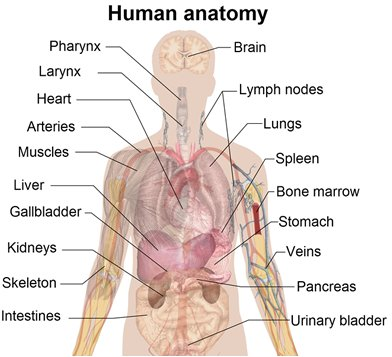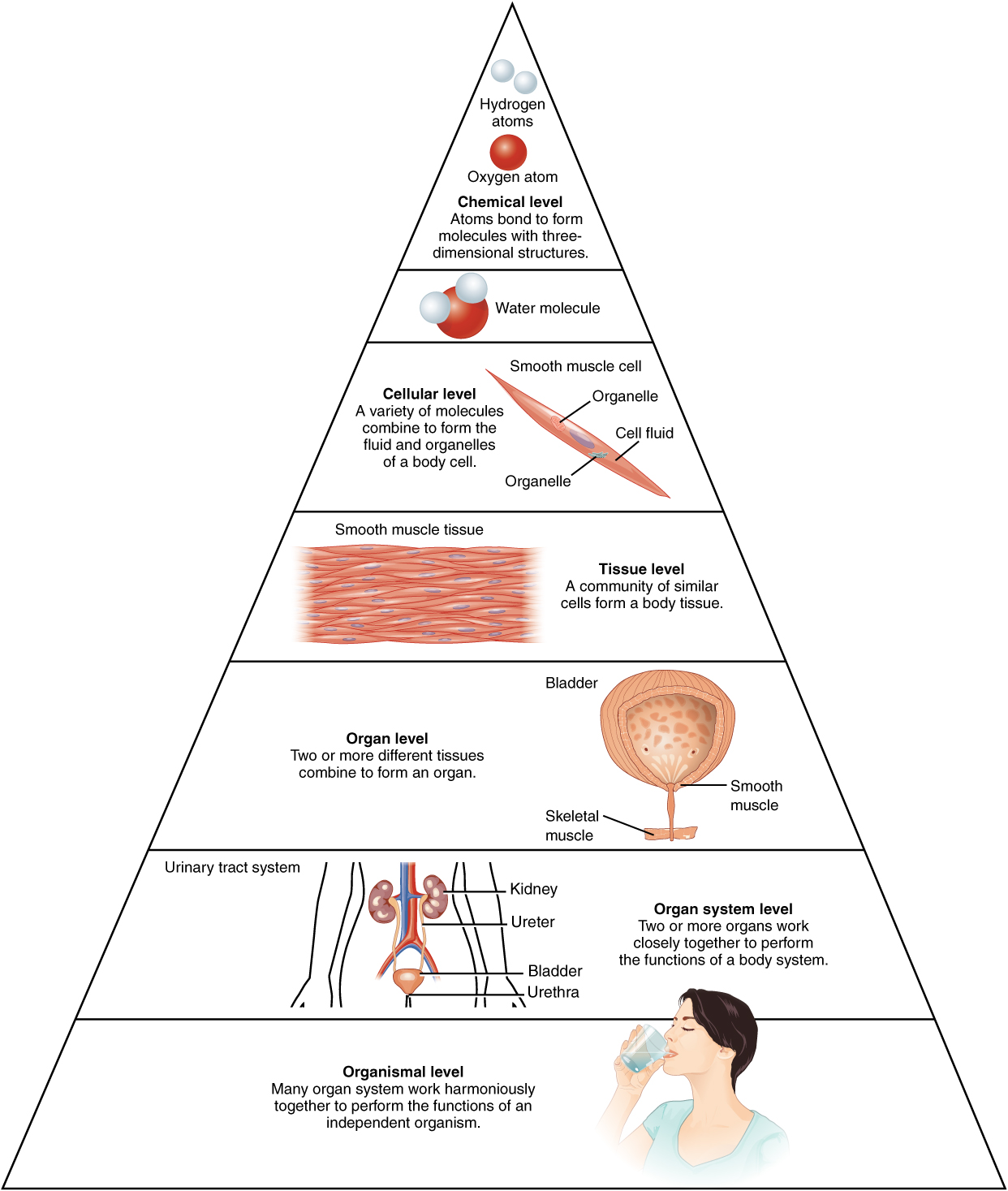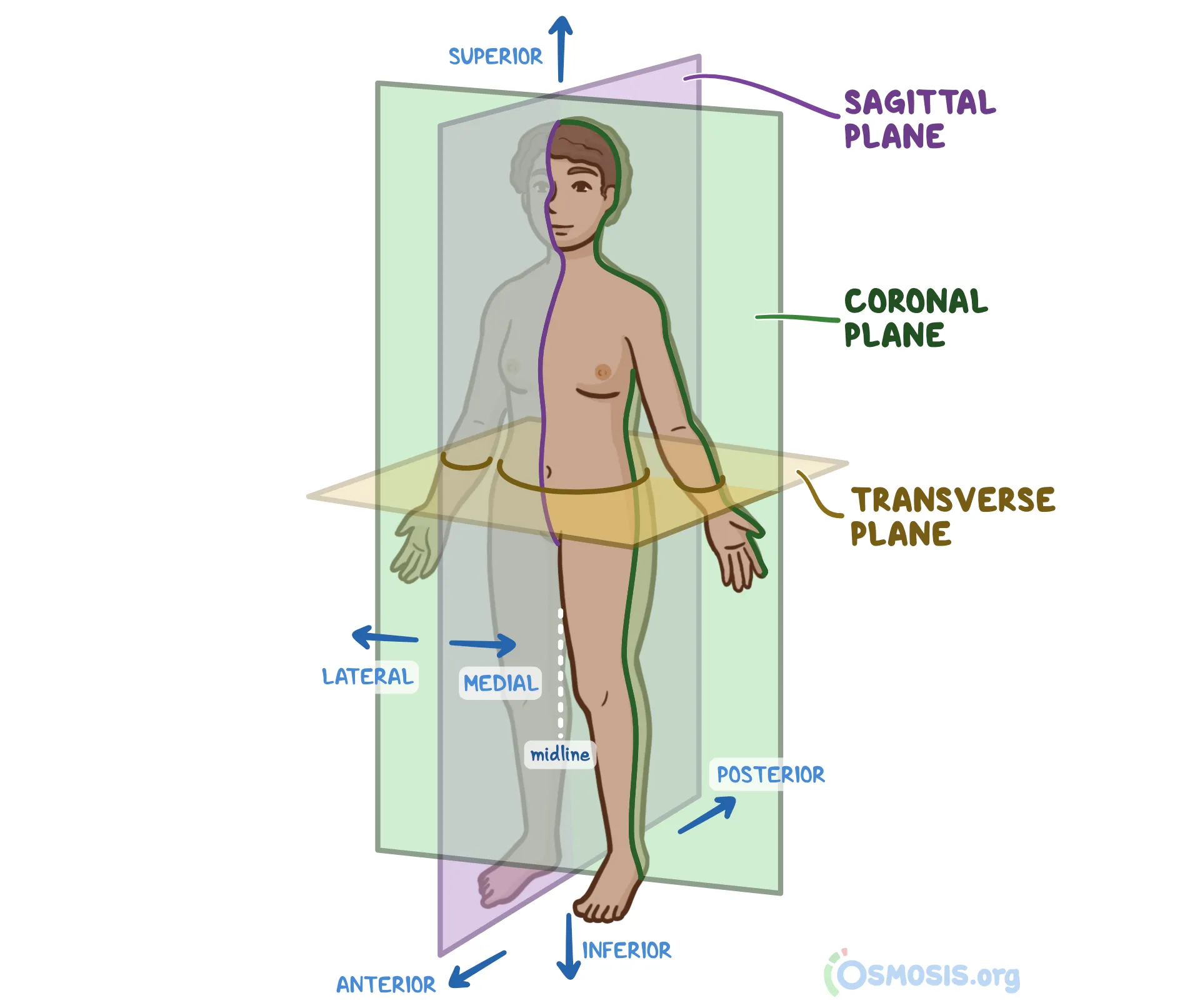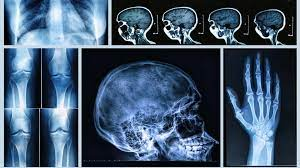Chapter 1: An Introduction to the Human Body

Overview of Anatomy and Physiology
- Human anatomy is the scientific study of the body’s structures.
- Some of these structures are very small and can only be observed and analyzed with the assistance of a microscope.
- Other larger structures can readily be seen, manipulated, measured, and weighed.
- The word “anatomy” comes from a Greek root that means “to cut apart.”
- Gross anatomy is the study of the larger structures of the body, those visible without the aid of magnification.
- Macro- means “large,” thus, gross anatomy is also referred to as macroscopic anatomy.anatomy. In contrast, micro- means “small”.
- Microscopic anatomy is the study of structures that can be observed only with the use of a microscope or other magnification devices.
Body’s structures:
- Regional anatomy is the study of the interrelationships of all of the structures in a specific body region, such as the abdomen.
- Studying regional anatomy helps us appreciate the interrelationships of body structures, such as how muscles, nerves, blood vessels, and other structures work together to serve a particular body region.
- Systemic anatomy is the study of the structures that make up a discrete body system—that is, a group of structures that work together to perform a unique body function.
- For example, a systemic anatomical study of the muscular system would consider all of the skeletal muscles of the body.
- Human physiology is the scientific study of the chemistry and physics of the structures of the body and the ways in which they work together to support the functions of life.
- Homeostasis is the state of steady internal conditions maintained by living things.
The study of physiology certainly includes observation, both with the naked eye and with microscopes, as well as manipulations and measurements.
- Neurophysiology is the study of the brain, spinal cord, and nerves and how these work together to perform functions as complex and diverse as vision, movement, and thinking.
Structural Organization of the Human Body

The Levels of Organization
- To study the chemical level of organization, scientists consider the simplest building blocks of matter: subatomic particles, atoms and molecules.
- All matter in the universe is composed of one or more unique pure substances called elements, familiar examples of which are hydrogen, oxygen, carbon, nitrogen, calcium, and iron.
- A cell is the smallest independently functioning unit of a living organism. Even bacteria, which are extremely small, independently-living organisms, have a cellular structure.
- A human cell typically consists of flexible membranes that enclose cytoplasm, a water-based cellular fluid together with a variety of tiny functioning units called organelles.
- A tissue is a group of many similar cells (though sometimes composed of a few related types) that work together to perform a specific function.
- An organ is an anatomically distinct structure of the body composed of two or more tissue types. Each organ performs one or more specific physiological functions.
- An organ system is a group of organs that work together to perform major functions or meet physiological needs of the body.
- Organs that work together are grouped into organ systems.
Functions of Human Life
Organization
Humans have trillions of compartmented cells.
- These compartments nourish cells.
- They isolate internal body fluids from the numerous germs that grow on body surfaces, including tract linings.
- Bacteria outnumber human cells in the gut, yet they cannot freely circulate.
Cell plasma membranes divide the intracellular environment—fluids and organelles—from the external environment.
- Blood veins close the circulatory system, and connective tissue sheaths isolate nerves and muscles.
- In the chest and abdomen, membranes separate the lungs, heart, and kidneys.
The integumentary system—skin, hair, and nails—is the biggest organ system.
Skin shields organs and fluids from bacteria and toxins.
Metabolism: Metabolism is the sum of all anabolic and catabolic reactions that take place in the body.
TWO TYPES OF REACTIONS:
- Anabolism is the process whereby smaller, simpler molecules are combined into larger, more complex substances.
- Your body can assemble, by utilizing energy, the complex chemicals it needs by combining small molecules derived from the foods you eat
- Catabolism is the process by which larger more complex substances are broken down into smaller simpler molecules.
- Catabolism releases energy.
- The complex molecules found in foods are broken down so the body can use their parts to assemble the structures and substances needed for life.
Movement
- Human movement includes not only actions at the joints of the body, but also the motion of individual organs and even individual cells.
Development, growth and reproduction
- Development is all of the changes the body goes through in life. Development includes the processes of differentiation, growth, and renewal.
- Growth is the increase in body size.
- Humans, like all multicellular organisms, grow by increasing the number of existing cells, increasing the amount of non-cellular material around cells (such as mineral deposits in bone), and, within very narrow limits, increasing the size of existing cells.
- Reproduction is the formation of a new organism from parent organisms. In humans, reproduction is carried out by the male and female reproductive systems.
- Because death will come to all complex organisms, without reproduction, the line of organisms would end.
Requirements for Human Life
Oxygen
- Oxygen is needed for several chemical reactions in the body, including ATP production.
- Atmospheric air contains around 20% oxygen.
- Because they produce ATP constantly, brain cells are susceptible to oxygen deficiency.
- Without oxygen, brain damage occurs in five minutes and death in 10.
Nutrients
- A nutrient is a substance in foods and beverages that is essential to human survival.
- The three basic classes of nutrients are water, the energy-yielding and body-building nutrients, and the micronutrients (vitamins and minerals).
- The most critical nutrient is water.
Narrow Range of Temperature
- The body can handle short-term heat or cold.
- Naturally, heat causes sweating. Sweat evaporates, cooling the body.
- To balance the loss of extracellular fluid during the sweat response, appropriate fluid intake is needed.
- Because humid air is laden with water, the sweat reaction is less effective. Thus, skin sweat cannot evaporate, raising body temperature alarmingly.
Narrow Range of Atmospheric Pressure
- Pressure is a force exerted by a substance that is in contact with another substance. Atmospheric pressure is pressure exerted by the mixture of gases (primarily nitrogen and oxygen) in the Earth’s atmosphere.
- Atmospheric pressure is always on your body.
- This pressure dissolves bodily gases like nitrogen.
- If you were evacuated from a spaceship above Earth's atmosphere, your pressure would drop dramatically.
- Your blood has a far higher nitrogen gas pressure than the space around you.
Homeostasis
- A set point is the physiological value around which the normal range fluctuates.
- A normal range is the restricted set of values that is optimally healthful and stable.
- Negative feedback is a mechanism that reverses a deviation from the set point.
Negative Feedback
Three basic components:
- A sensor, also referred to a receptor, is a component of a feedback system that monitors a physiological value. This value is reported to the control center.
- The control center is the component in a feedback system that compares the value to the normal range. If the value deviates too much from the set point, then the control center activates an effector.
- An effector is the component in a feedback system that causes a change to reverse the situation and return the value to the normal range.
Positive Feedback
- Positive feedback intensifies a change in the body’s physiological condition rather than reversing it.
- A deviation from the normal range results in more change, and the system moves farther away from the normal range.
- Positive feedback in the body is normal only when there is a definite end point.
Anatomical Terminology
- Anatomical position is that of the body standing upright, with the feet at shoulder width and parallel, toes forward.
- Prone describes a face-down orientation, and supine describes a face up orientation.
- These terms are sometimes used in describing the position of the body during specific physical examinations or surgical procedures.
Directional Terms
- Anterior (or ventral) Describes the front or direction toward the front of the body. The toes are anterior to the foot.
- Posterior (or dorsal) Describes the back or direction toward the back of the body. The popliteus is posterior to the patella.
- Superior (or cranial) describes a position above or higher than another part of the body proper. The orbits are superior to the oris.
- Inferior (or caudal) describes a position below or lower than another part of the body proper; near or toward the tail (in humans, the coccyx, or lowest part of the spinal column). The pelvis is inferior to the abdomen.
- Lateral describes the side or direction toward the side of the body. The thumb (pollex) is lateral to the digits.
- Medial describes the middle or direction toward the middle of the body. The hallux is the medial toe.
- Proximal describes a position in a limb that is nearer to the point of attachment or the trunk of the body. The brachium is proximal to the antebrachium.
- Distal describes a position in a limb that is farther from the point of attachment or the trunk of the body. The crus is distal to the femur.
- Superficial describes a position closer to the surface of the body. The skin is superficial to the bones.
- Deep describes a position farther from the surface of the body. The brain is deep to the skull.
Body Planes

- [ ] A section is a two-dimensional surface of a three-dimensional structure that has been cut.
- [ ] A plane is an imaginary two-dimensional surface that passes through the body.
Three Planes:
- The sagittal plane is the plane that divides the body or an organ vertically into right and left sides.
- If this vertical plane runs directly down the middle of the body, it is called the midsagittal or median plane.
- If it divides the body into unequal right and left sides, it is called a parasagittal plane or less commonly a longitudinal section.
- The frontal plane is the plane that divides the body or an organ into an anterior (front) portion and a posterior (rear) portion.
- The frontal plane is often referred to as a coronal plane. (“Corona” is Latin for “crown.”)
- The transverse plane is the plane that divides the body or organ horizontally into upper and lower portions. Transverse planes produce images referred to as cross sections.
Subdivisions of the Posterior (Dorsal) and Anterior (Ventral) Cavities
- The posterior (dorsal) and anterior (ventral) cavities are each subdivided into smaller cavities.
- In the posterior (dorsal) cavity, the cranial cavity houses the brain, and the spinal cavity (or vertebral cavity) encloses the spinal cord.
- The thoracic cavity is the more superior subdivision of the anterior cavity, and it is enclosed by the rib cage. The thoracic cavity contains the lungs and the heart, which is located in the mediastinum.
- The abdominopelvic cavity is the largest cavity in the body.
Membranes of the Anterior (Ventral) Body Cavity
- A serous membrane (also referred to a serosa) is one of the thin membranes that cover the walls and organs in the thoracic and abdominopelvic cavities.
- The pleura is the serous membrane that surrounds the lungs in the pleural cavity; the pericardium is the serous membrane that surrounds the heart in the pericardial cavity; and the peritoneum is the serous membrane that surrounds several organs in the abdominopelvic cavity.
Medical Imaging

X-Rays
German physicist Wilhelm Röntgen (1845–1923) was experimenting with electrical current when he discovered that a mysterious and invisible “ray” would pass through his flesh but leave an outline of his bones on a screen coated with a metal compound.
- In 1895, Röntgen made the first durable record of the internal parts of a living human: an “X-ray” image (as it came to be called) of his wife’s hand.
The X-ray is a form of high energy electromagnetic radiation with a short wavelength capable of penetrating solids and ionizing gases.
Computed Tomography: Computed tomography (CT) is a noninvasive imaging technique that uses computers to analyze several cross-sectional X-rays in order to reveal minute details about structures in the body.
Magnetic Resonance Imaging: Magnetic resonance imaging (MRI) is a noninvasive medical imaging technique based on a phenomenon of nuclear physics discovered in the 1930s, in which matter exposed to magnetic fields and radio waves was found to emit radio signals.
Positron Emission Tomography: Positron emission tomography (PET) is a medical imaging technique involving the use of so-called radiopharmaceuticals, substances that emit radiation that is short-lived and therefore relatively safe to administer to the body.
Ultrasonography: Ultrasonography is an imaging technique that uses the transmission of high-frequency sound waves into the body to generate an echo signal that is converted by a computer into a real-time image of anatomy and physiology.